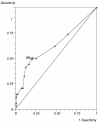Efficacy of the motile sperm organelle morphology examination (MSOME) in predicting pregnancy after intrauterine insemination
- PMID: 21861903
- PMCID: PMC3170256
- DOI: 10.1186/1477-7827-9-120
Efficacy of the motile sperm organelle morphology examination (MSOME) in predicting pregnancy after intrauterine insemination
Abstract
Background: Although the motile sperm organelle morphology examination (MSOME) was developed merely as a selection criterion, its application as a method for classifying sperm morphology may represent an improvement in the evaluation of semen quality. The aim of this study was to determine the prognostic value of normal sperm morphology using MSOME with regard to clinical pregnancy (CP) after intrauterine insemination (IUI).
Methods: A total of 156 IUI cycles that were performed in 111 couples were prospectively analysed. Each subject received 75 IU of recombinant FSH every second day from the third day of the cycle. Beginning on the 10th day of the cycle, follicular development was monitored by vaginal ultrasound. When one or two follicles measuring at least 17 mm were observed, recombinant hCG was administered, and IUI was performed 12-14 h and 36-40 h after hCG treatment. Prior to the IUI procedure, sperm samples were analysed by MSOME at 8400× magnification using an inverted microscope that was equipped with DIC/Nomarski differential interference contrast optics. A minimum of 200 motile spermatozoa per semen sample were evaluated, and the percentage of normal spermatozoa in each sample was determined.
Results: Pregnancy occurred in 34 IUI cycles (CP rate per cycle: 21.8%, per patient: 30.6%). Based on the MSOME criteria, a significantly higher percentage of normal spermatozoa was found in the group of men in which the IUI cycles resulted in pregnancy (2.6+/-3.1%) compared to the group that did not achieve pregnancy (1.2+/-1.7%; P = 0.019). Logistic regression showed that the percentage of normal cells in the MSOME was a determining factor for the likelihood of clinical pregnancy (OR: 1.28; 95% CI: 1.08 to 1.51; P = 0.003). The ROC curve revealed an area under the curve of 0.63 and an optimum cut-off point of 2% of normal sperm morphology. At this cut-off threshold, using the percentage of normal sperm morphology by MSOME to predict pregnancy was 50% sensitive with a 40% positive predictive value and 79% specificity with an 85% negative predictive value. The efficacy of using the percentage of normal sperm morphology by MSOME in predicting pregnancy was 65%.
Conclusions: The present findings support the use of high-magnification microscopy both for selecting spermatozoa and as a routine method for analysing semen before performing IUI.
Figures


Similar articles
-
Motile sperm organelle morphology examination (MSOME): intervariation study of normal sperm and sperm with large nuclear vacuoles.Reprod Biol Endocrinol. 2010 Jun 7;8:56. doi: 10.1186/1477-7827-8-56. Reprod Biol Endocrinol. 2010. PMID: 20529256 Free PMC article.
-
The possibility of integrating motile sperm organelle morphology examination (MSOME) with intracytoplasmic morphologically-selected sperm injection (IMSI) when treating couples with unexplained infertility.PLoS One. 2020 May 1;15(5):e0232156. doi: 10.1371/journal.pone.0232156. eCollection 2020. PLoS One. 2020. PMID: 32357155 Free PMC article.
-
The effects of male age on sperm analysis by motile sperm organelle morphology examination (MSOME).Reprod Biol Endocrinol. 2012 Mar 19;10:19. doi: 10.1186/1477-7827-10-19. Reprod Biol Endocrinol. 2012. PMID: 22429861 Free PMC article.
-
Semen quality and intrauterine insemination.Reprod Biomed Online. 2003 Oct-Nov;7(4):485-92. doi: 10.1016/s1472-6483(10)61894-9. Reprod Biomed Online. 2003. PMID: 14656412 Review.
-
The evaluation of pre and post processing semen analysis parameters at the time of intrauterine insemination in couples diagnosed with male factor infertility and pregnancy rates based on stimulation agent. A retrospective cohort study.Eur J Obstet Gynecol Reprod Biol. 2014 Aug;179:159-62. doi: 10.1016/j.ejogrb.2014.05.003. Epub 2014 May 20. Eur J Obstet Gynecol Reprod Biol. 2014. PMID: 24965998 Free PMC article. Review.
Cited by
-
A comprehensive evaluation of pre- and post-processing sperm parameters for predicting successful pregnancy rate following intrauterine insemination with the husband's sperms.BMC Pregnancy Childbirth. 2022 Sep 12;22(1):703. doi: 10.1186/s12884-022-05029-8. BMC Pregnancy Childbirth. 2022. PMID: 36096780 Free PMC article.
-
B-Ultrasound Image Analysis of Intrauterine Pregnancy Residues after Mid-Term Pregnancy Based on Smart Medical Big Data.J Healthc Eng. 2022 Feb 16;2022:9937051. doi: 10.1155/2022/9937051. eCollection 2022. J Healthc Eng. 2022. Retraction in: J Healthc Eng. 2023 Oct 18;2023:9780604. doi: 10.1155/2023/9780604. PMID: 35222901 Free PMC article. Retracted.
-
Prognostic factors in intrauterine insemination cycles.JBRA Assist Reprod. 2018 Mar 1;22(1):2-7. doi: 10.5935/1518-0557.20180002. JBRA Assist Reprod. 2018. PMID: 29327861 Free PMC article.
-
A Survey on Main Semen Parameters in Natural Pregnancy and Intrauterine Insemination: Are There Any Significant Differences?Am J Mens Health. 2018 May;12(3):617-623. doi: 10.1177/1557988316647966. Epub 2016 May 4. Am J Mens Health. 2018. PMID: 27192715 Free PMC article.
-
Large nuclear vacuoles in spermatozoa negatively affect pregnancy rate in IVF cycles.Iran J Reprod Med. 2015 Jul;13(7):425-32. Iran J Reprod Med. 2015. PMID: 26494990 Free PMC article.
References
-
- Group TECW. Intrauterine insemination. Hum Reprod Update. 2009;15:265–277. - PubMed
-
- Marchetti C, Dewailly D. Intrauterine insemination: indications and methods. Rev Prat. 2006;56:500–506. - PubMed
-
- Bensdorp AJ, Cohlen BJ, Heineman MJ, Vandekerckhove P. Intra-uterine insemination for male subfertility. Cochrane Database Syst Rev. 2007. p. CD000360. - PubMed
-
- Baccetti B. Microscopical advances in assisted reproduction. J Submicrosc Cytol Pathol. 2004;36:333–339. - PubMed
MeSH terms
LinkOut - more resources
Full Text Sources
Other Literature Sources
Miscellaneous

